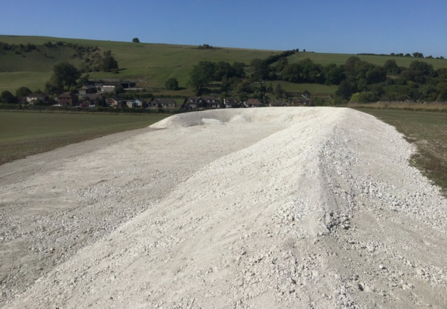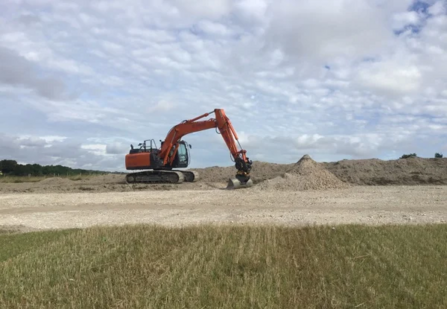
Building a Butterfly Bank at Coombe Bissett Down

Arguably one of the best views of Wiltshire Wildlife Trust’s Coombe Bissett Down nature reserve is only a little way from the car park, where the ancient strip lynchets (terraces that were cut into the steep chalk slopes for farming) rise from one side and rolling chalk downs fall steeply away to reveal fields below. From here the vista is a pleasant mix of scrub, grasslands and treelines accompanied by the squawks of rooks clamouring overhead, and if you’re lucky a kestrel sailing along your sightline in the breeze.
Recently there has been a new addition to the usual sights of this diverse reserve: in the recently acquired 17-hectare field to the north-west of the reserve, a snaking mound of chalk has appeared. This brilliant white structure that skims the skyline is Coombe Bissett Down’s brand new butterfly bank, a feature that will help to support some of the reserve’s rare invertebrates.
When planted, the gleaming white bank will be a fundamental food source not for butterflies themselves but for their larvae – who are rather picky eaters. Its chalk slopes are fantastic for early-succession wildflower species that like the bare chalk such as kidney and horseshoe vetch and birds-foot trefoil, all low-growing species that thrive on steep banks with thin soil and plenty of sunlight.
The sunshine yellow horseshoe vetch, for example, is a vital food source for the larvae of the striking Adonis blue. Dingy skipper larvae can feed on both bird-foot trefoil and horseshoe vetch, whilst the larvae of the tiny small blue feeds on fluffy kidney vetch flower heads. Ashley White, Reserve Manager at Coombe Bissett Down, is hopeful that the butterfly bank will encourage the reserve’s existing butterfly colonies to spread further throughout the site.
By supplying food sources for all stages of a butterfly’s lifecycle, the Trust hopes to create prime habitats for butterflies and their larvae to flourish.
The bank was expertly constructed by MJ Abbot’s most experienced digger operator, ‘PJ’. A keen wildlife lover himself and no stranger to building butterfly banks (the Trust’s being his fourth!) he’s pleased to be able to give positively back to nature, something that he gets so much joy from.

As well as being rich in wildlife, these chalk downs have proved to be rich in history, and during the initial excavations of the butterfly bank an exciting discovery was made. Wessex Archaeology found what they believed to be evidence of an ancient strip lynchet – like the ones that terrace the upper stretches of Coombe Bissett Down. This fantastic find in the bedrock was thought to have formed between the Bronze Age and Roman period and proves that this area has been cultivated for millennia.
With the main construction now finished, a mixture of seed and plug plants will be used to adorn the chalky slopes to transform it into a buffet for caterpillars.
The Trust is inviting local residents and visitors to help sow and plant up the new butterfly bank, whilst learning more about the diverse range of species that can be found on their doorstep. Keep an eye on the Wiltshire Wildlife Trust’s website and social media pages (Facebook and Twitter) pages to find out more about the community events taking place on these marvellous downs and how you can be a part of giving the wildlife here a helping hand.

